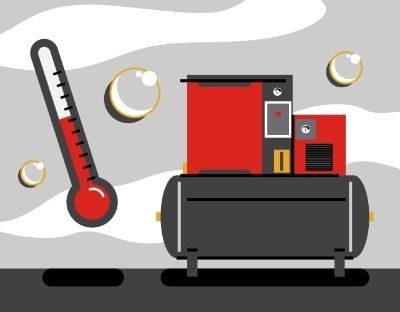Proportioning the Compressed Air Dryer
Trying to figure out which air dryer capacity is best for you? Here are some factors to consider. Read More…

The simple answer, dewpoint is the temperature at which condensation begins to form. The longer answer is dewpoint is the temperature at which water vapor in your compressed air is no longer vapor, and changes to a liquid form (condensation).
As your compressor is compressing air, the stored air can become very warm, meaning that it contains a lot of water vapor. As the air cools down, that vapor will turn to condensation. If enough condensation forms, you now have free-flowing water through your air lines.
Having water in your compressed air is never a good thing, and depending on the application, it can become catastrophic.
Dewpoint readings can help diagnose several problems, so monitor the drying-air dewpoint throughout an entire dryer cycle.
Below are a few reasons to consider when your dryers' dewpoint spikes:
- Dirty Heat Exchanger
- Failed Cooling Fan
- Overloading the dryer either by high inlet temperature, high ambient temperature or low pressure
- Faulty drain valve
- Failed pre-filters
- Ambient air is leaking into the closed-loop circuit and causing premature loading of the desiccant.
- Totally inactive regeneration circuit or badly contaminated desiccant (or loss of refrigerant)
- Operate the dryer in a clean, temperature controlled, dry indoor area with minimum outlet piping to avoid back pressure on the purge line.
The Dewpoint Demand control is an energy saver that can extend the drying cycle without purging, during periods of lower moisture loads. The Dewpoint Demand system offers, in one compact package, the utmost in flexibility and accuracy sensing the actual dewpoint of the outlet air. The hygrometer senses the dewpoint at the outlet of the dryer at the end of the drying cycle, and extends the drying cycle until the preset adjustable dewpoint setpoint is reached. During this extended drying cycle, the purge valves are closed and the opposite tower is pressurized and prepared for the drying cycle. The dewpoint demand option reduces purge loss and extends valve life. This option consists of the following:
• Digital Dewpoint Display • Adjustable Setpoints • High Humidity Alarm Light with Dry Contact
Calibration:To maintain accuracy, the probe should be recalibrated annually. Recalibrated probes are available through your local distributor.
Probe Replacement: Isolate and depressurize the probe chamber. Disconnect the sensor cable from the sensor. Remove, and replace the probe. Pressurize the probe chamber and connect the sensor cable. A small amount of sample air (approximately 2-10 SCFH) should expel out the chamber needle valve.
Thank you to CP Compressors for video and technical article.
Do you have an idea for our #expertcorner? Let
us know!
Ash Air has been around in New Zealand since 1979, and we’ve grown into a nationwide company with international support and a reputation for quality and reliability.We look after all things compressed air for your business!
Ash Air's range of Chicago Pneumatic, Alup, Pneumatech, and Quincy compressors are used extensively around the world in industries ranging from oil and gas to food, automotive and farming, and we bring you these world class compressors here in the land of the long white cloud.Our technicians are compressed air equipment experts and are dedicated to addressing customer needs. Supported by a 13 locations nationwide, Ash Air offers one of the widest selections of compressed air equipment and parts available today in New Zealand.
With Ash Air compressors, you can count on reliability and high performance for even the most demanding applications. We focus our efforts on the following:
Talk to the team today:
Proportioning the Compressed Air Dryer
Trying to figure out which air dryer capacity is best for you? Here are some factors to consider. Read More…
Maintenance budget: 8 factors to consider
Just like any other equipment, a compressed air installation also requires the necessary maintenance work during its entire lifespan. Even though maintenance costs are only about 5 to 10% of a machine's annual operating costs, failure to budget for maintenance can have potentially disastrous consequences. Read More…
The air dyer is one of the most ignored cooler in the system. A dirty condenser will cause water in the lines, or worse it will cause complete dryer failure. Read More…